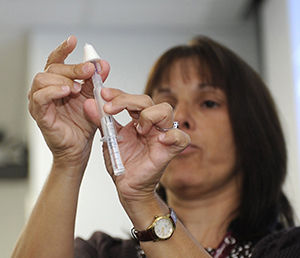Students question effectiveness of recent heroin overdose antidote

Dr. Bethany DiPaula, a pharmacist with the Howard County Health Department, demonstrates how to put together a syringe of Naloxone Aug. 11, 2014 at an opiate overdose response training session which is being held at the Howard County Health Department in Columbia, Md.
March 11, 2015
In 2012, Ohio saw its highest heroin death toll of 680 people according to the Department of Health — a record-breaking number expected to continually rise.
In its wake, public health emergencies were declared in Massachusetts to stop the problem, and 2,750 Delaware citizens sought rehabilitation treatment, some as young as 12 years old.
Cuyahoga County has joined the list of affected areas. The county’s medical examiner saw 194 heroin-related deaths in 2013, and 212 from October 2013 to October 2014, according to Cleveland.com. This means the county is on pace to meet or exceed numbers from previous years.
A life-saving drug called naloxone entered the prescription market in 2014. In March 2014, Gov. John Kasich signed the bill allowing friends and family of heroin addicts to acquire naloxone in case of opioid overdose.
Naloxone reverses the effects of opioids (including other prescription drugs) on the brain, acting as a lifeline for many users battling addiction. According to the Cuyahoga County Board of Health, naloxone saved 75 lives last year.
In April 2014, senior public relations major Ricky Salcer lost his half-brother to a heroin overdose.
Salcer grew up always wanting to be just like his brother; however, after they moved away from each other, their contact weakened. He was placed in rehabilitation and, shortly after, returned to using heroin.
Salcer’s brother violated his probation the day before his birthday and almost overdosed. Police told him he would spend the night in jail for his violation, but he refused. Salcer’s brother shot the amount of heroin he used before his rehabilitation, an amount his body could not handle, and died.
Salcer’s reaction to the recent pass of no-prescription-necessary naloxone is one of weariness despite his brother’s death.
“If it worked once and they caught on to it, they’d just always fall back on it,” Salcer said. “It’s kind of like a lifeline with no consequences because you can just rely on (naloxone).”
The naloxone debate has become more heated since Kasich’s approval to allow administration of the drug with no prescription. Friends and family are not only legally permitted, but also highly encouraged to carry the antidote in the case of an overdose.
“If you got (people) to rely on a shot to save them, it’s either going to increase the amount they take or increase their frequency of taking it,” Salcer said.
Salcer is not the only one affected indirectly by heroin. Freshman pre-nursing major Jaylan Williams lost her best friend in February 2014 to a heroin overdose as well.
“I found out at like three in the morning, before her own brother,” Williams said. “I was the one who told him. That was really hard on me because I was good friends with him, too.”
Williams said she didn’t believe it at first and thought the overdose was a joke. She described the death of her best friend as the worst experience she’s had to go through.
With naloxone on the market, Williams supports the use and administration of the drug to friends and families in need of a solution to save their loved ones.
“I think it’s a good thing because most of the people I know that do heroin already think they’re invincible. That’s why she passed away,” Williams said. “They think they can do a huge amount of the drug and be OK.”
Recently, Amphastar Pharmaceuticals, Inc., manufacturer of naloxone, dramatically increased the cost of the naloxone injection. According to the Record-Courier, Ohio Attorney General Mike DeWine announced that Amphastar and the state have agreed to rebate those purchasing the syringe from March 2, 2015 to March 1, 2016. If Amphastar continues to raise the wholesale price of the life-saving drug, Ohio will also increase the amount rebated.
Families and friends affected by opioids, specifically heroin, have the opportunity to join forces with an overdose education and naloxone distribution program called Project DAWN, or Deaths Avoided With Naloxone.
Project DAWN informs participants on how to recognize signs of an overdose, perform rescue breathing and how to administer naloxone. Project DAWN is located at as many as 27 different sites in Ohio.
Statewide initiatives toward controlling the sale, use and deaths from heroin continue to reach toward getting naloxone as readily available as possible. However, heroin and opioid pain pills have killed more than 125,000 in the last decade according to federal data.
“Heroin is a brutal thing…I bet you there’s countless students on campus affected by it, and the numbers continue to grow,” Salcer said. “Something definitely needs to be done about it.”
Contact Payton Moore at [email protected].











